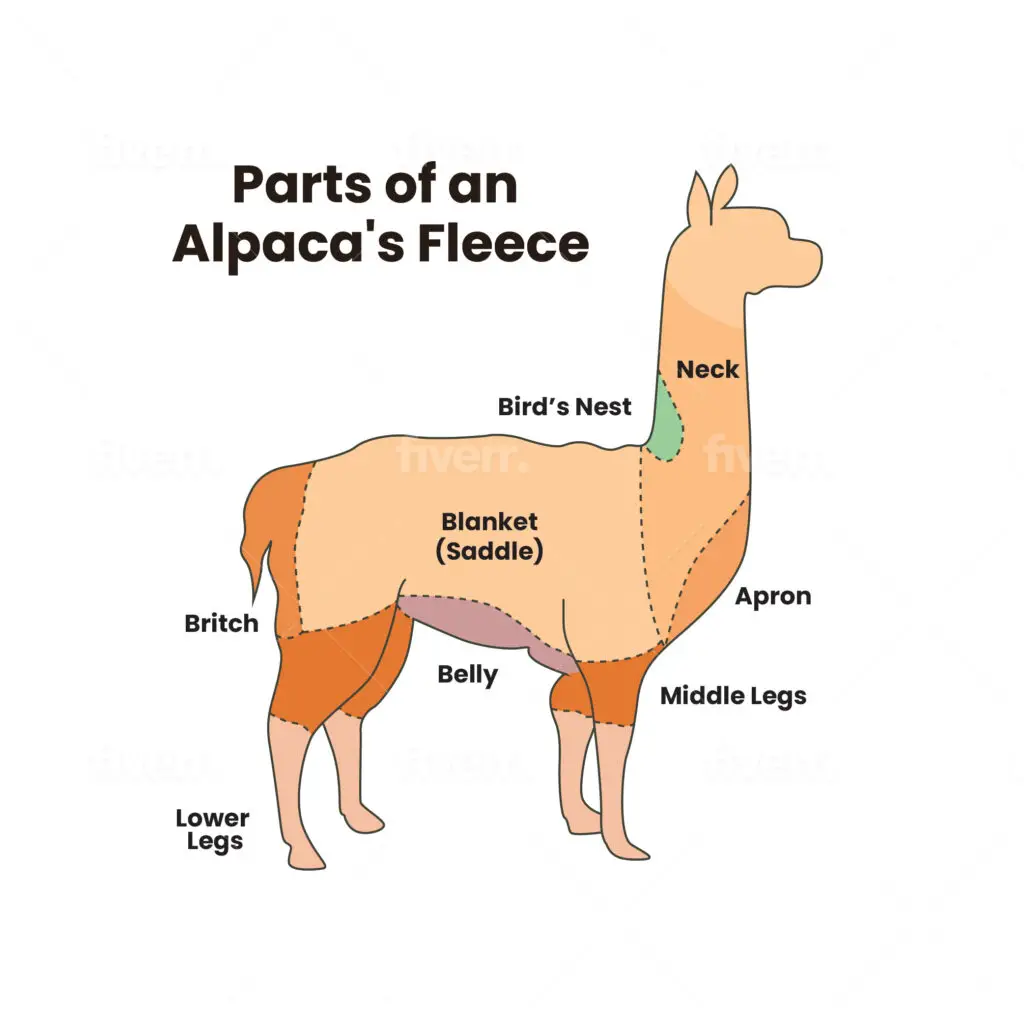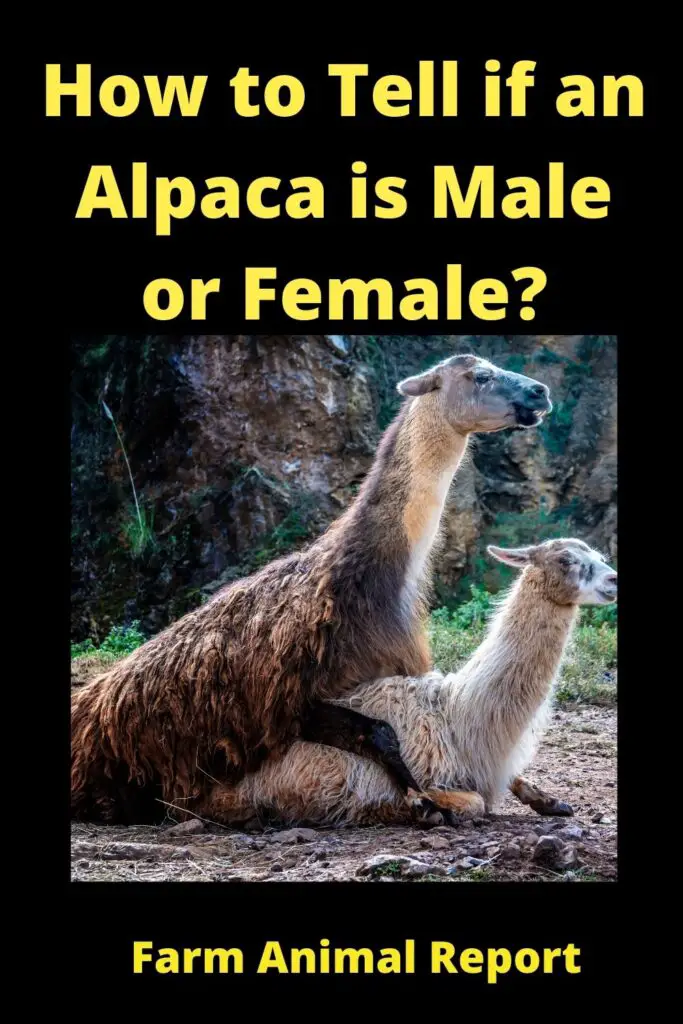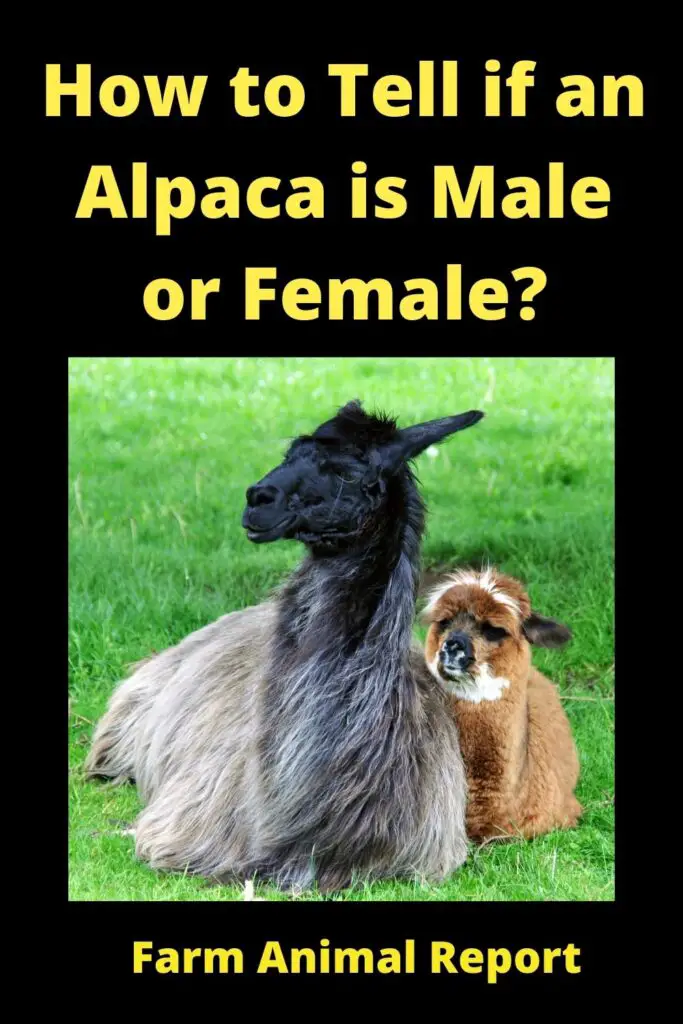As a General Rule Male alpacas are more aggressive than females and tend to establish the dominance of their herd group. In some cases, alpha males will immobilize the head and neck of a weaker or challenging male in order to show their strength and dominance. Both females and males are extremely protective of each other and their offspring. Generally speaking, the alpaca is extremely alert to any animal or human entering its pasture.
Difference Between Male and Female Alpaca
How to Tell if an Alpaca is Male or Female?
Alpacas are kept as pets and livestock worldwide because of their cute, gentle, and soft characteristics. Alpacas are domesticated vicunas, which are South American ruminants that live in the Andes high up in the mountains and are utilized for various things. Alpacas are closely associated with llamas, which are domesticated variants of the guanaco, a wild ruminant native to the Andes. Llamas and alpacas are closely related to one another in appearance and behavior. In contrast to llamas, which are developed primarily for their capacity to carry large burdens, alpacas are cultivated primarily for their luxuriously soft fleece.
We can distinguish between male and female Alpacas by visualizing their reproductive organs, i.e., male or female components in their bodies. Secondary sexual characteristics can also contribute to the determination of whether alpaca is male or female. Other factors include weight, height, temperament, etc.
Difference Between Male and Female Alpaca – Alpacas may be found in swampy mountainous regions ranging from southern Colombia and Ecuador southward to northern Chile and northern Argentina. This species is distinguished by its long neck and long legs and its short tail, tiny head, and prominent pointed ears, all of which are thin in build.
What Is Better a Male or Female Alpaca?
Both male and female have their own usage. Bur female Alpacas are much docile and smaller than males.
But to select male or female is entirely dependent on the owners’ preference and usage. First and foremost, keep in mind that alpacas are herd animals, and they must remain in herds for the sake of their health.
List of Differences Between Males and Females
Size
An adult male alpaca’s height is typically between 81 and 99 centimeters (32 and 39 inches) at the shoulders (withers), while the female’s average height at the shoulder is 3.1 feet or 91.4 millimeters in height.
Guanacos are somewhat larger than alpacas and significantly larger than Vicuas; however, they are smaller and less heavily built than llamas. Guanacos are found in South America. Guanacos are somewhat larger than alpacas, but they are far more significant than vicunas in terms of size. Alpacas are considered the smallest members of the camelid family.
Color
Both male and female Alpacas have the somewhat same coloration. The alpaca’s matted coat is often black or brown, and it may also be seen in various other colors, ranging from lighter shades of gray or brown to pale yellow and, in rare instances, even white.
16 naturally occurring colors of both male and female alpaca f that are globally recognized, ranging from white to black.

Weight
Difference Between Male and Female Alpaca – Male Alpacas are typically in the range from 48 to 84 kg (106 and 185 pounds), while the female weighs a little less i.e., 40 to 45 kg (88 and 99 pounds).
Population
Only about three million alpacas are left globally, with the vast majority (94 percent) found in South America. Huacaya alpacas account for 93% of the world’s population, with Suri alpacas accounting for the remaining 7%. In the United Kingdom, there are around 45,000 registered alpacas, with 350,000 in the United States and 350,000 in Australia.
60-70 % of Alpacas of the total population is female, while 25-30% are male.
Types
Generally speaking, both male and female alpacas may be divided into breeds: the Huacaya, pronounced wa-ky-ya, and the Suri. There are no structural differences between the two varieties or species, with the huacaya developing fiber at right angles to the skin. They acquire a crimp to the staples, while the Suri fiber hangs in locks and has more luster than the huacaya.
Do Male Alpacas Have Horns on Their Heads?
No, Alpacas are a pleasure to be around and are typically gentle and simple to care for. Alpacas do not head-butt each other. They are not equipped with horns or hooves, as are other cattle.
Do Alpacas Spit?
Members of the camelid family, including Alpacas, utilize spitting to communicate their displeasure with one another. When it comes to food, alpacas can become territorial, and they may express their aggressiveness by spitting on each other. They are not aggressive when it comes to other animals. Additionally, they are known to spit on one another when there is a disagreement within the herd (usually involving males). Humans sometimes also become victims of their spitting. But remember, it is harmless but has a stinky and foul odor. Therefore it is important to watch their behavior and learn to avoid their spit.
What Is Male Alpaca Called?
Machos is the term used to refer to male Alpacas.
What Is Female Alpaca or Baby Alpaca Called?
Alpacas females are referred to as Hembras, yearlings are referred to as Tuis, and newborns are called Crias.
Amount of Wool
Alpacas are generally sheared every two years, with the Suris producing fine fleeces weighing around 3 kg (6.5 pounds) per animal and the Huacayas producing coarser fleeces weighing approximately 2.5 kg (4.5 pounds) per animal (5.5 pounds). Hair growth in the huacaya is around 30 cm (12 inches) in two years, while in the Suri it is approximately 60 cm (23.6 inches) in two years. During shearing, individual fibers inside the fleece range in length from around 20 to 40 cm (about 7.9 to 15.7 inches) at the time of shearing.
Male produces a little more fleece as compared to female Alpacas because they are a little bigger in size.

Lifespan
Both male and female Alpacas have an average life span of 15–20 years, depending on the breed. Alpacas that live in their natural territories, the Andes, often have a shorter life than those who do not. This is because the animals are utilized in the terminal market when the quality of the fiber begins to deteriorate.
The animals are utilized for their fiber production until the quality of the fiber begins to deteriorate at the age of 8 to 10 years. They will then be slaughtered for their skins and flesh at that moment. They also have a reduced life expectancy in the Andes due to the intense weather and environmental conditions they are exposed to.
The oldest known alpaca lived for 27 years, according to historical records. We have not been very diligent in our documentation up until lately. Over the thousands of years that alpacas have been domesticated, some of them may have lived longer lives than others.
Guarding Abilities

Difference Between Male and Female Alpaca – Alpacas, like other camelids, are robust, clever, and friendly animals that have developed strong herd social instincts as a result of their evolutionary history.
Although males and females are different in many ways, both females and males are extremely protective of each other and their offspring. Generally speaking, the alpaca is extremely alert to any animal or human entering its paddock. It has excellent vision over great distances, even over kilometers, making it an excellent guard animal. Even though they are normally quite quiet, when they are aroused to the possibility of a threat, alpacas may give an audible warning cry that can be heard by their whole herd as well as by landowners.
They are generally amicable toward people and other animals who are not viewed as harmful, but they have evolved a deep dislike for the predatory species known as foxes through the course of time. However, keep in mind that they are just as vulnerable to attack by wild dogs as sheep are, so use caution.
They will follow or pursue the predator with their front feet, and if necessary, they will strike at or on the attacker with their front feet, rising off the ground and resting on their back legs before bringing their front legs down with great speed and strength. When alpacas are aroused in this fashion, they are highly quick and may catch and kill a predator in a short amount of time.
According to the researchers, there is more evidence to show that alpacas can deter eagles from attacking their herds.
Herd guards are most effective when working in pairs and should be at least 18 months old. Two alpacas can readily protect at least 100 ewes or goats, but additional alpacas may be required for bigger herds of sheep or goats. Alpacas are herd animals; therefore, keeping just one alpaca is not a wise decision.
When purchasing a herd guard, it is critical to check that the male alpacas have been castrated before purchasing. The castration of male herd guards is necessary. Otherwise, sexually mature males will spend their time fighting among themselves and become rather hostile towards the sheep or goats they are supposed to protect.
Furthermore, castrated alpacas are frequently calmer and easier to handle than uncastrated alpacas. Also, mature female alpacas are excellent herd protectors because of their maternal drive, and they form powerful bonds with their flocks.
Herd guards will begin defending your sheep or goat herd as soon as they are introduced to them, but it may take some time for them to become acquainted with their new flock, mainly if your paddock is big. It is recommended that the alpacas spend 4-6 weeks getting to know the paddock and bonding with the rest of the flock. However, there have been accounts of farmers who, after experiencing heavy losses due to foxes, have added alpacas to their flocks after lambing and kidding have begun and have seen no additional losses as a result of the introduction.
Feed and Supplement
Both male and female Alpacas are herbivores, which means they eat plants exclusively. They primarily consume grass, although they may also consume other plant materials such as leaves, wood, bark, and stems. Alpacas have a three-chambered stomach, similar to that of other ruminants, which allows them to digest roughage efficiently.
Alpacas, in contrast to other grazers, do not consume a large amount of food. A 125-pound (57-kg) alpaca consumes just about 2 pounds (907 grams) of food each day on average. Alpacas consume around 1.5-2 percent of their body weight each day on average.
With average stocking rates of six to seven per acre, regular grass can be grown and provided to them. In addition to providing hay or haylage throughout the year, forage-based supplements can be provided in the latter stages of pregnancy, during nursing, weaning, and throughout the winter months. In general, you can keep one more alpaca per acre than keep sheep on the same amount of land.
Teeth
Alpacas have inherited their teeth from their wild ancestors, which is why they have such beautiful smiles. Llamas and alpacas (both male and female) have the same number as well as kind of teeth (they have the same dental formula): molars, incisors, and canines (which are the same as in humans). Alpacas’ teeth have traits with both llamas and vicunas; for example, they often have no or little enamel on the tongue side of their teeth and continue to grow teeth well into maturity.
Male alpacas have bigger teeth than female alpacas. As a result of male fighting behavior, typical injuries include ripped or severed ears, permanently damaged tails, lacerated testicles, and lifelong limb lameness due to torn tendons and ligaments in the legs.
Male Parts (Alpaca)
An individual male camelid has a significant influence on the reproductive success and genetic improvement of a whole herd.
The male reproductive organs of the alpaca have been extensively studied and documented. The scrotum is nonpendulous and nonadjacent to the perineal region and is located high in the perineal area at the level of the ischial arch. The testicles are tiny compared to those of other domestic cattle, and they are oriented caudodorsally in this animal. Located along the dorsal boundary of the testis, the epididymis has its head curling around the cranial pole of the testis, allowing it to face laterally.
These geographical changes indicate a variety of secretory activities that may be involved in the process of sperm maturation and development. At the confluence of the epididymis and the ductus deferens in the alpaca, the ductus deferens have a diameter of one millimeter (mm). It increases in size to 2 mm in the abdominal cavity as it approaches the pelvic urethra (ampulla). The ductus deferens measure around 40 centimeters in length (cm).

Female Parts (Alpaca)
When it comes to llamas, their ovaries range from ellipsoid to globular (1.3–2.5 cm in size), and those of alpacas range from smaller (0.9–1.3 cm in size) to larger (1.3–1.9 cm in size) depending on the structures that are present on the ovaries. The ovaries of both species are similar in size (1.3–1.9 cm in size).
Depending on the individual, the weight of each ovary ranges between 2.1 and 2.39 grams (g).
Small follicles ranging in size from 2.2 to 4.9 mm can be seen on the surface of the mature/healthy ovary in adult female Alpacas. Even though transrectal massage is not easily seen, especially in young animals, they become plainly obvious by ultrasound once they have developed to a diameter of 3 mm or higher.
Cumulus oocyte complexes (COCs) in llamas and alpacas are black and immediately distinguishable through the follicle wall when illuminated from the side by trans-illumination. In the case of immature oocytes, the germinal vesicle was quite prominent and big, and it had a black nucleolus. Mature oocytes have a metaphase stage bordered by a black region that is visible under low magnification conditions. The apex of the oviduct generates a wide circular aperture inside which the fimbriae of the oviduct are located.
Cost of Ownership
Alpacas are not inexpensive to acquire, but they are cost-effective to ‘run.’ Breeding female Alpacas are priced in the range of $3500 – $10,000, depending on their age and overall quality. Included in the purchase is confirmation of pregnancy as well as a veterinarian health certificate and delivery. Geldings will cost between $700 and $1750, depending on their size. Stud males can range in price from $7,000 to $50,000, depending on their quality and progeny quality. The actual number of animals you need, as well as the ratio of males to female Alpacas, will be determined solely by your objectives and needs.
The following are the usual expenses associated with each animal:
- Throughout the year, alpacas require access to soft meadow hay to maintain their health. 1.8 percent of their body weight in dry matter fiber per day has been determined to be sufficient. During the winter months, it is estimated that this corresponds to around 1.4 kilograms of hay every day, or 40 kilograms per month. A typical little bale of hay may weigh approximately 20 kg and cost roughly $5, resulting in a monthly cost of $10 per head for a normal household.
- The feed Camelibra developed by Gro Well Feeds recommended for alpacas that require additional minerals and vitamins. The typical daily allotment is 75gms, which is equivalent to $8 per head per day. Additional supplementation may be necessary during the winter months, in which case we offer Fibregest, which is made by Gro Well Feeds. A normal ration adds an extra $4 per head per day to the daily expense of living.
- Veterinary care and preventative treatment generally twice a year, for a total cost of $70.00. We will presume that breeders have attended a husbandry course and have learned how to do routine vaccinations, toenail clipping, and other procedures on their own.
- Several alpaca shearers travel around with charges varying based on the number of alpacas and the distance traveled. Prices range from $8 per animal to $18, depending on the distance traveled.
- Grass care and upkeep must be included in the cost of the property.
- Female re-mating services range from $550 to $1,800 per service.
- Insurance against death and theft is advised for breeding females and stud males at a rate of 3.5 percent of the animal’s worth.
18 ways Alpaca Farmers make Money
How Old Can You Breed Alpacas?
Often, breeders want to get the most money out of a female breeding alpaca, so they breed them at a young age to optimize their financial return. Alpacas typically achieve breeding maturity between the ages of twelve and twenty-four months, with some reaching the age of thirty months. Some alpacas have indeed conceived successfully as early as five months, but this is not a procedure that is safe for either the mother or the cira.
- Having a female alpaca breed too soon might result in issues that put the lives of both the female and the newborn alpacas at peril.
- You should wait until your female alpaca weighs at least 88 pounds before allowing her to procreate.
Are Alpacas Hazardous?
No. Alpacas are a pleasure to be around and are typically gentle and simple to care for. Alpacas do not head-butt each other. They are not equipped with horns or hooves, as are other cattle. They glide smoothly and deftly about the field, making it unlikely that they will purposefully collide with or run over someone. Male alpacas grow strong fighting teeth at the age of three, harming people and other alpacas if they are not restrained. Alpacas will kick with their rear legs as a reaction, especially if they are approached from behind. The impact of an alpaca kick is less severe than that of a horse’s kick, but it can still cause bruising. Additionally, toenails can cut the skin.
When interacting with alpacas, owners and visitors should exercise prudence and common sense, just as they do when working with any other animal. Individuals working with alpacas should dress in long pants and shoes or boots with a good grip covering the whole foot. To properly handle alpacas and all camelids, people must first acquire their trust by speaking calmly and minimally. Educating new alpaca owners on how to manage their animals for herd management is best done by experienced alpaca owners or industry specialists.
Final Thoughts
Both male and female Alpacas are great pets. If trained from a very young age, they can be tamed and become friendly with their owners. It is possible to tell the difference between male and female Alpacas by looking at their reproductive organs. Besides primary sexual features, secondary sexual characteristics may also be used to determine if an alpaca is male or female. Other considerations include body weight, height, temperament, and so forth.


